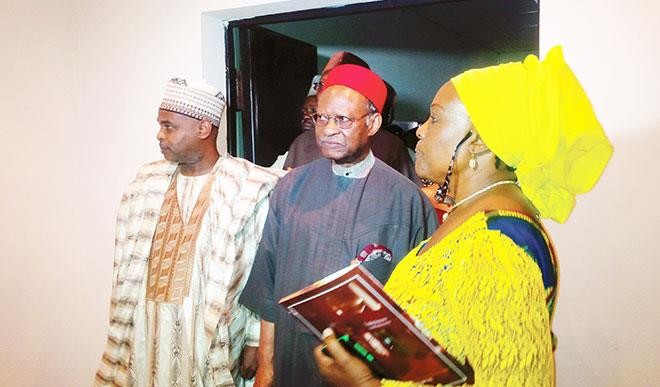Celebrating Nigerian museums at 70
The National Commission for Museums and Monuments has marked 70 years since the establishment of museums in Nigeria. This milestone has been celebrated in exhibitions and displays of culture and heritage. Daily Trust reports on activities to commemorate the occasion. In a ceremony which took place in Esie, Kwara State on November 15, the National […]


The National Commission for Museums and Monuments has marked 70 years since the establishment of museums in Nigeria. This milestone has been celebrated in exhibitions and displays of culture and heritage. Daily Trust reports on activities to commemorate the occasion.
In a ceremony which took place in Esie, Kwara State on November 15, the National Commission for Museums and Monuments (NCMM) celebrated 70 years of its existence in Nigeria. Esie is home to Nigeria’s first museum set up in 1945.
Penultimate Thursday at the National Museum, Onikan, Lagos, which was commissioned in 1957, the NCMM celebrated with the exhibition – ‘An enduring legacy’ – which showcased bead works from across the six geo-political zones of the country where these are a part a the culture.
Terra cotta, masks, sculptures, raffia works, pottery, bronze and wood among others were displayed in the about eight exhibition rooms of the museum – the oldest dating back to the 12th century.
Chairman of the event, Chief Emeka Anyaoku, who described Nigerian museums as still in early development stage, was critical of the state of museums in Nigeria.
Urging the Federal Government to salvage Nigeria’s museums in deplorable states and in dire need of proper funding, he said: “If the Minister of Information and Culture, Alhaji Lai Mohammed were to be present at this event, I would have appealed to him personally to consider the rehabilitation of the museums.”
He added that there are artefacts of inestimable value in Nigeria’s museums, which also have priceless collections to show the world, including Nok terra cotta, Benin bronze, Ife bronze, Igbo Ukwu and the Dufuna canoe.
The former Secretary General of the Commonwealth, said the international exhibition, ‘2000 years of Nigerian Art,’ organised by the museum in London some 40 years ago, was a hugely successful one because it opened the eyes of Europe to the fact that Nigeria has history.
“It is important that there are different artefacts that represent and tell the story and culture of the Nigerian people as well as promote cultural aspirations,” he stressed, adding that, since independence, Nigeria has promoted African culture on the continent and the Diaspora and that museums have a critical role to play in the development and pride of Nigeria.
On the need to further tell the African story, Anyaoku urged the museum management to collaborate with museums on the continent and beyond, for: “by so doing you will be winning respect in the comity of nations.” The event underscores the unity of Nigeria because the exhibits show common traits among Nigerians. He said one of the main challenges of the Commission is preserving works for posterity sake which he said is very costly venture.
Chairman, House of Representatives Committee on Culture and Tourism, Hon. Omoregie Ogbeide-Ihama said it was a milestone worth celebrating in the face of what Nigeria has been able to celebrate in terms of her heritage, over time and the ability have preserved it. “It is something we should be proud of. However, there is room for improvement especially to attract tourists.” He said creativity and innovations are areas government’s support should be sought in the culture sector, to create the enabling environment for private investors.
Director-General of the Commission, Mallam Yusuf Abdallah Usman, said there was more support needed in terms of government funding, “integrating what we do into school curriculum so that the museum is also a resource and history centre.”
The event will be followed by a national art competition for secondary schools with other events to hold in April and May next year in commemoration of the International Monument Day and International Museum Day respectively. A gala night to launch some of the Commission’s publications will hold in January.
According to the curator of the museum, Mrs. Edith Ekunke, the exhibition highlights common objects from various ethnic groups across Nigeria with binding cultural elements. The items, mainly collected by Nigerian archaeologists, ethnographers and other researchers during the tenures of the various museum chiefs, Kenneth C. Murray, Bernard Fagg, Eko Eyo, Ade Obayemi, Sule Bello, Yaro Gella, Eluyemi Omotoso, Joseph Eboreime and Usman.
The major attraction in the museum in Esie is the large numbers of human-shaped stone figures, depicting human activities. The popular myth surrounding them among locals is that the people of the town committed a grievous offence and thunder struck, turning everyone into a stone – in the act of what they were doing at the time – as reflected by the stones.
Generally, Nigerians would not ordinarily visit museums. Ayankou encouraged a change of attitude in this regard stating that: “It is important for us to learn about ourselves and the history from where we are coming. We need to recognise the things we have in common to strengthen the sense of unity that exists among us.”
